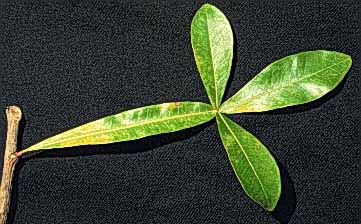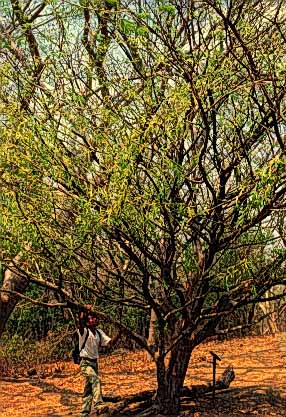
Crescentia alata Kunth.
Jicaro
(Bignoniaceae)
|
Crescentia alata Kunth. Jicaro (Bignoniaceae) | |
Masís, A, Espinoza, R., Guadamuz, A., Perez, D.and Chavarría, F. 1998. Crescentia alata (Bignoniaceae) Species Page, May 13, 1998. Species Home Pages, Area de Conservación Guanacaste, Costa Rica. http://www.acguanacaste.ac.cr
Tree 10 m tall.
Flower:
The cauliflorous (growing out of the trunk) flowers are greenish-yellow and purplish (Janzen 1983). They have a strong, foul odor.
Fruit:
The fruit, known as jicaro, are large, green and round. They begin to mature when fall to the ground.
Leaves:
The leaves are trifoliate and the petiole is winged. New leaves appear with the first rains.
|
Upper surface of the leaf |
Under surface of the leaf |
Bark and wood:
Whole plant architecture:
The crown in very open.
 | |
View of the architecture of the tree | |
Similar species:
Crescentia cujete, but this species has simple leaves and the fruits are much bigger.
Verification:
II.Geographic distribution:
International:
Central Mexico to the Southern part of South America (Janzen 1983).
In Costa Rica:
In the Area de Conservación Guanacaste:
In old pasturess and second growth of semideciduous and deciduous forests.
Map of macro-habitats of the
ACG |
III. Natural History:
It is one of the fruits that was dispersed by megafauna of the Pleistocene. Actually the horse has assumed this role, eating the mature fruits on the ground.
It is polinated by bats and the flower has a strong odor that is perceptable when you are near a tree.
IV. How to find:
In the Santa Rosa, Centeno, Pocosol, and El Hacha sectors, among others.
Acknowledgements.
This project was carried out by the Area de Conservación Guanacaste/CR, with help from INBio/CR, ICBG from the Foggarty center, NIH/USA and NSF/USA.
Thanks to Kate Beattie for helping with the image management and the translation of this species page.
Literature cited:
Janzen, D. H. Ed. Costa Rican Natural History. The University of Chicago Press, Chicago.1983. Pag 225.